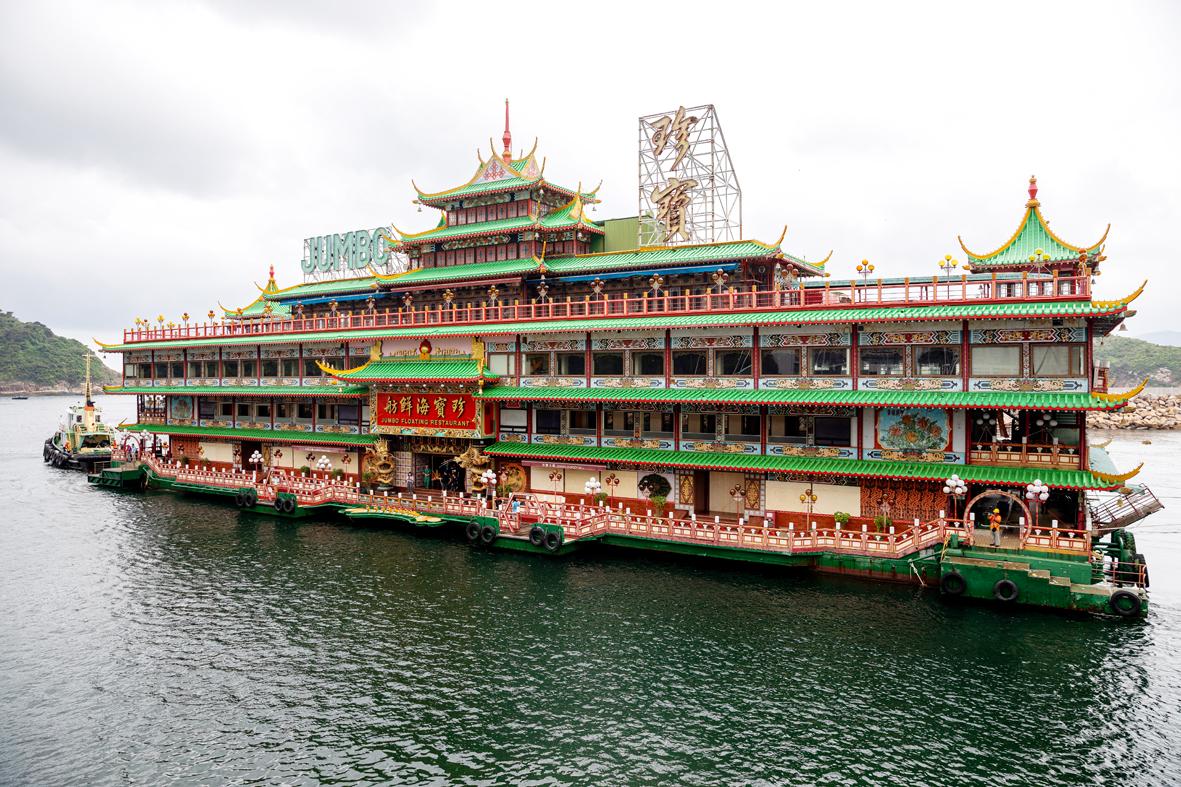Hong Kong’s Jumbo Floating Restaurant, a famed but aging tourist attraction that featured in multiple Cantonese and Hollywood films, was towed out of the city Tuesday after years of revitalization efforts went nowhere.
The buoyant behemoth, which at 76 meters long could house 2,300 diners, set out shortly before noon from the southern Hong Kong Island typhoon shelter where it has sat for nearly half a century. Designed like a Chinese imperial palace and once considered a must-see landmark, the restaurant drew visitors from Queen Elizabeth II to Tom Cruise, and featured in several films — including Steven Soderbergh’s Contagion, about a deadly global pandemic. The lavish restaurant’s operators cited the COVID-19 pandemic as the reason for finally closing its doors in March 2020, after around a decade of financial woes. Restaurant owner Melco International Development announced last month that ahead of its license expiration this month, Jumbo would leave Hong Kong and await a new operator at an undisclosed location.
Under overcast skies, a scattered group of onlookers gathered on the Aberdeen waterfront to see it be dragged away. Watching the restaurant’s ponderous progress across the shelter waters was Mr Wong, a 60-year-old man who said he had come specially to see its departure.

Photo: EPA-EFE
“The exterior was for many years a symbol of Hong Kong,” he said, adding he had eaten there once 20 years ago. “I believe it will come back and I look forward to it.”
Opened in 1976 by the late casino tycoon Stanley Ho (何鴻燊), the Jumbo Floating Restaurant embodied the height of luxury, reportedly costing over HK$30 million (US$3.8 million) to build. It featured a “dragon throne” in the style of the Ming dynasty as well as an opulent mural, according to the South China Morning Post.
The restaurant’s berth in Aberdeen harbor was traditionally a hotspot for seafood eateries — and fierce competition for customers only cooled when Jumbo’s operators acquired its biggest competitor, Tai Pak Floating Restaurant, in the 1980s.
The restaurant was kept afloat by Hong Kong’s booming tourism industry but its popularity had dimmed in recent years even before the coronavirus hit.
Restaurant operator Melco said last month the business had not been profitable since 2013 and cumulative losses had exceeded HK$100 million (US$12.7 million).
It was still costing millions in maintenance fees every year and around a dozen businesses and organizations had declined an invitation to take it over at no charge, Melco added. In her 2020 policy address, Hong Kong leader Carrie Lam (林鄭月娥) announced plans to turn the restaurant over to local theme park Ocean Park for revitalization, but the project fell through after the park said it could not find a suitable operator.
The ailing restaurant’s fate was sealed just days before Lam is set to leave office. In a sign of its dilapidation, on June 1, Jumbo’s kitchen boat listed into the water after a suspected hull breach, tilting almost 90 degrees. The derelict kitchen boat will be left behind, according to local media.

We lay transfixed under our blankets as the silhouettes of manta rays temporarily eclipsed the moon above us, and flickers of shadow at our feet revealed smaller fish darting in and out of the shelter of the sunken ship. Unwilling to close our eyes against this magnificent spectacle, we continued to watch, oohing and aahing, until the darkness and the exhaustion of the day’s events finally caught up with us and we fell into a deep slumber. Falling asleep under 1.5 million gallons of seawater in relative comfort was undoubtedly the highlight of the weekend, but the rest of the tour

Youngdoung Tenzin is living history of modern Tibet. The Chinese government on Dec. 22 last year sanctioned him along with 19 other Canadians who were associated with the Canada Tibet Committee and the Uighur Rights Advocacy Project. A former political chair of the Canadian Tibetan Association of Ontario and community outreach manager for the Canada Tibet Committee, he is now a lecturer and researcher in Environmental Chemistry at the University of Toronto. “I was born into a nomadic Tibetan family in Tibet,” he says. “I came to India in 1999, when I was 11. I even met [His Holiness] the 14th the Dalai

Music played in a wedding hall in western Japan as Yurina Noguchi, wearing a white gown and tiara, dabbed away tears, taking in the words of her husband-to-be: an AI-generated persona gazing out from a smartphone screen. “At first, Klaus was just someone to talk with, but we gradually became closer,” said the 32-year-old call center operator, referring to the artificial intelligence persona. “I started to have feelings for Klaus. We started dating and after a while he proposed to me. I accepted, and now we’re a couple.” Many in Japan, the birthplace of anime, have shown extreme devotion to fictional characters and

Following the rollercoaster ride of 2025, next year is already shaping up to be dramatic. The ongoing constitutional crises and the nine-in-one local elections are already dominating the landscape. The constitutional crises are the ones to lose sleep over. Though much business is still being conducted, crucial items such as next year’s budget, civil servant pensions and the proposed eight-year NT$1.25 trillion (approx US$40 billion) special defense budget are still being contested. There are, however, two glimmers of hope. One is that the legally contested move by five of the eight grand justices on the Constitutional Court’s ad hoc move